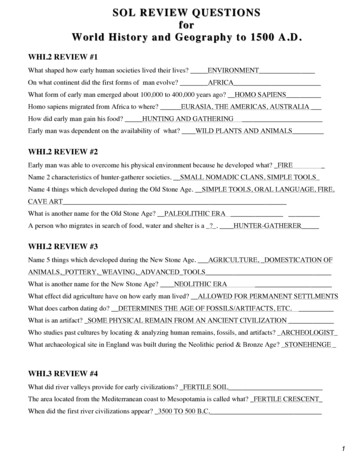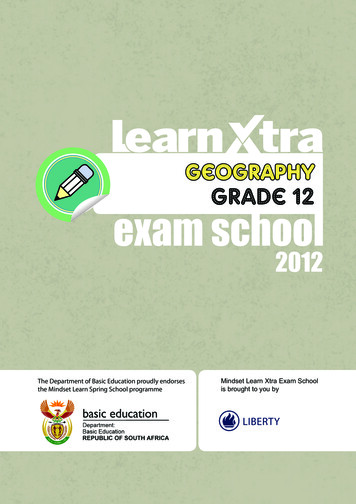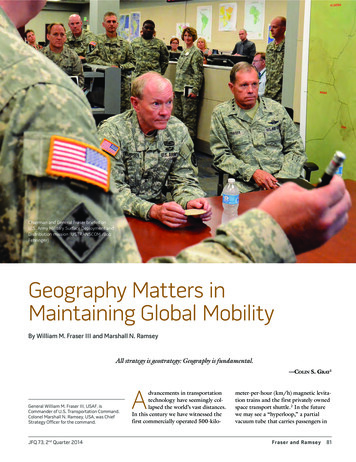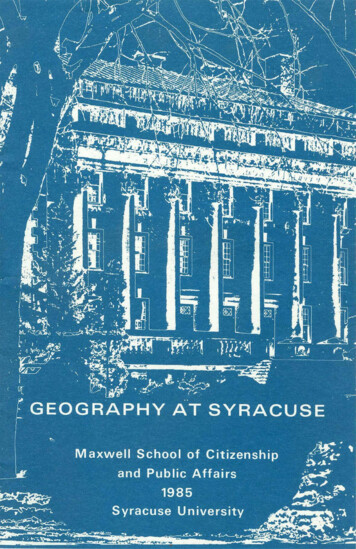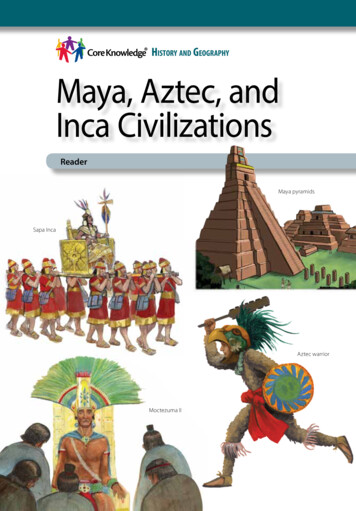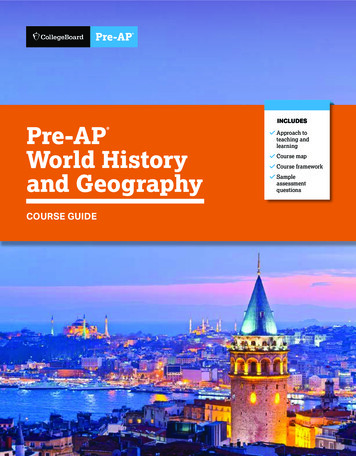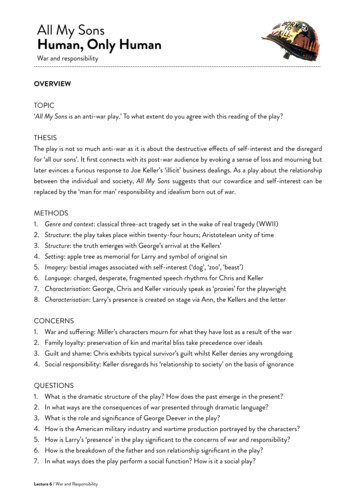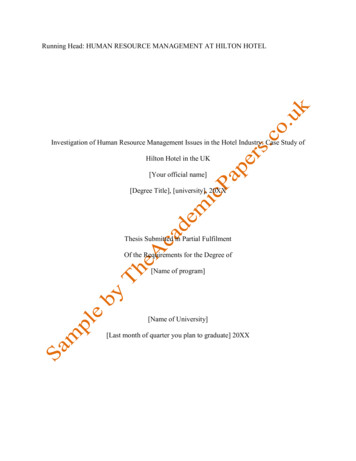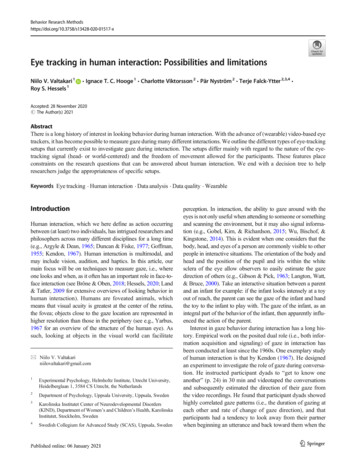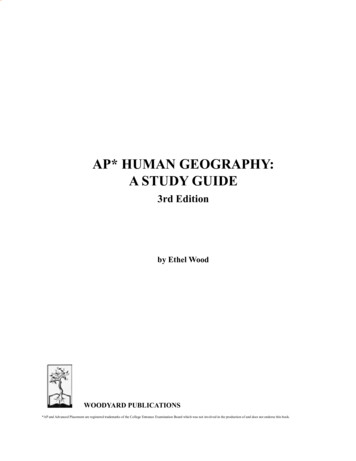
Transcription
AP* HUMAN GEOGRAPHY:A STUDY GUIDE3rd Editionby Ethel WoodWOODYARD PUBLICATIONS*AP and Advanced Placement are registered trademarks of the College Entrance Examination Board which was not involved in the production of and does not endorse this book.
AP Human Geography: A Study Guide, 3rd edition, by Ethel WoodPublished byWoodYard Publications285 Main Street, Germantown, NY, U.S.A.Ph. 610-207-1366Fax 610-372-8401www.woodyardpublications.comemail: ejw@woodyardpublications.comTABLE OF CONTENTSPREFACE.5SECTION ONE: Unit ReviewsUNIT ONE: Geography: Its Nature and Perspectives.8UNIT ONE: Multiple-Choice Questions.25UNIT ONE: Free-Response Question.30UNIT TWO: Population.31UNIT TWO: Multiple-Choice Questions.58UNIT TWO: Free-Response Question.64UNIT THREE: Cultural Patterns and Processes.65UNIT THREE: Multiple-Choice Questions.92UNIT THREE: Free-Response Question.98UNIT FOUR: Political Organization of Space.99UNIT FOUR: Multiple-Choice Questions.124UNIT FOUR: Free-Response Question.129UNIT FIVE: Agriculture: Primary Economic Activities.130UNIT FIVE: Multiple-Choice Questions.155UNIT FIVE: Free-Response Question.161UNIT SIX: Industrialization and Economic Development.162UNIT SIX: Multiple-Choice Questions.187UNIT SIX: Free-Response Question.192All rights reserved. No part of this book may be reproduced or transmitted in any form or by anymeans, electronic or mechanical, including photocopying, recording or by any information storageand retrieval system, without written permission from the author, except for the inclusion of briefquotations in a review.Copyright 2012 by Ethel WoodISBN 978-0-9831766-6-4Cover Photo: Sacred Valley, Peru (photo by Claudia Coburn)UNIT SEVEN: Cities and Urban Land Use.193UNIT SEVEN: Multiple-Choice Questions.219UNIT SEVEN: Free-Response Question.225SECTION TWO: Sample ExaminationsSample Examination One.227Sample Examination Two.246
PREFACEA Note from the AuthorWhy Human Geography?5PREFACE: THE HUMAN GEOGRAPHY EXAMINATIONI taught social studies classes for many years, mostly at Princeton High School in Princeton, NewJersey. Like most social studies teachers, my experience included classes in United States historyand government. I have also published review books, textbooks, readers, and web materials that haverequired me to do extensive research in various types of American studies. Needless to say, I believethat an education in these areas is incredibly important for high school students, and every secondarycurriculum should include them. So why is human geography so important?The 21st century has taught us that we cannot ignore the world around us. Happenings around theglobe now directly impact our lives, and social studies teachers and students around the country facethe challenge of interpreting a complex, interactive world. The AP human geography course focuseson spatial organization – the location of places, people, and events, and the connections among placesand landscapes that shape virtually all human endeavors on the planet.No matter whether the Human Geography Exam is your first experience with AP tests or just one ofseveral, it is important to know what you will face when the day of the examination comes. So let’sstart with an overview of the exam format. The AP Human Geography Examination is approximately2 hours and 15 minutes long, and it is divided into two basic parts: 75 multiple-choice questions (60 minutes allowed; 50% of the exam grade)3 free-response questions (75 minutes allowed; 50% of the exam grade)The multiple-choice questions cover all the topics listed on the following page in the same proportionas indicated. The questions are challenging. Some points to keep in mind about the multiple-choicesection are:It is my hope that this book will help students to grasp something of the complexities of our globalenvironment, and gain some understanding of geographic commonalities and differences. In today’sworld, we cannot afford not to know. On the exam, the College Board no longer subtracts one-fourth of the number of questions answeredincorrectly from the number of questions answered correctly. So if you have no idea how to answera question, you might as well choose an answer since there is no penalty for guessing.Ethel WoodGermantown, NYAugust 2012 Some questions are based on charts, photographs, and maps, so it is important to carefully considerthe visual information provided, including the title and the two axes of a chart or graph. Sometimesthese questions just require that you read the chart correctly, but sometimes you must also havesome content knowledge in order to answer correctly. Be prepared for EXCEPT, NOT, and LEAST questions, such as “All of the following are physicalsite characteristics of a location EXCEPT:” These are sometimes called “reverse multiple-choicequestions,” and they require you to identify the only incorrect answer. These questions take practicebecause you must reverse your thinking practices in order to answer them correctly.Other Books by Ethel WoodAmerican Government: A Complete Coursebook (Great Source Books)AP Comparative Government and Politics: An Essential Coursebook and Study Guide (5 editions)(WoodYard Publications)AP European History: An Essential Coursebook (WoodYard Publications)AP United States History: An Essential Coursebook (WoodYard Publications)AP World History: An Essential Coursebook (2 editions) (WoodYard Publications)The Immigrants: An Historical Reader (Nextext Books)Introduction to Sociology (Nextext Books)Multiple Choice and Free-Response Questions in Preparation for the AP United States Governmentand Politics Examination (6 editions) (D&S Marketing Systems)Multiple Choice and Free-Response Questions in Preparation for the AP World History Examination(2 editions) (D&S Marketing Systems)Teacher’s Guide - AP Comparative Government and Politics (College Board)The Best Test Preparation for the Graduate Record Examination in Political Science (REA)The Presidency: An Historical Reader (Nextext Books)This book has multiple-choice questions that follow each section of the review, as well as 75 multiplechoice questions in each of the two sample exams at the end. The questions are very similar to thosethat you will encounter on the College Board exam.In the free-response section, you must answer ALL three equally weighted questions, and you shouldspend approximately 25 minutes on each one. The questions may concentrate on one topic, but oftenthey require you to interrelate concepts from different areas. Some of the questions are based onstimulus materials – such as maps, charts, graphs, diagrams, or photographs. There are no formal timedivisions among the free-response questions. Instead, a total of 75 minutes is allotted to answer all ofthem, so it is important to keep up with the time, and not spend so long on one question that you don’thave time to complete the others. Be sure to answer all parts of each question. Your response will begraded according to a rubric that assigns a certain number of points to each section of the question.Generally, multiple-choice questions are distributed among these seven topic areas within the percentagerange indicated:
6PREFACEI.Geography: Its Nature and Perspectives 5-10%II.Population .13-17%III.Cultural Patterns and Processes . 13-17%IV.Political Organization of Space .13-17%V.Agricultural and Rural Land Use . .13-17%VI.Industrialization and Economic Development .13-17%VII.Cities and Urban Land Use .13-17%As you can see, six of the seven topic areas are weighted exactly the same, so it is important to studyall areas as equally as possible.AP Human Geography: A Study Guide is designed to help you prepare for the exam by giving you asound footing in human geography concepts and topics. Your best preparation for the exam is to knowyour stuff. The questions do require reading and writing skills, but the surer you are of the material, themore likely you are to answer the questions correctly. This book provides the concepts and information,as well as plenty of practice questions that will prepare you for the exam. Most importantly, I hopethat you learn something about human geography, and that you learn to love it, too!A note about dates: The dates in this book are defined by either “B.C.E.” (Before the Common Era)or “C.E.” (Common Era). They correspond to the older system of “B.C.” and “A.D.”UNIT REVIEWS5SECTION ONE: UNIT REVIEWSThis section includes review materials for the seven major topics of the AP Human Geography Course.Each section is followed by a set of multiple-choice questions and one free-response question.
8UNIT ONEGEOGRAPHY9Often these patterns and places combine into regions – large areas that may be compared to other largeareas. Some patterns and places may reach many areas of the world so that geographers may commenton the effects of globalization. Spatial organization defines human life on earth, with all of its similaritiesand differences, and the spatial analysis tradition is an integral part of the geographical perspective.GEOGRAPHY AS A FIELD OF STUDYThe word “geography” is probably a familiar one to you since most people take geography for granted.Geography is concerned with place and location – two concepts that are inherently important parts ofeveryday life. However, the Advanced Placement Geography course invites you to see your worldthrough the lens of the geographer, and in doing so encourages you to enlarge your vision to encompassother places and locations and consider them in new ways.Don’t make the mistake of thinking of a geographer as merely someone that can name all the rivers,lakes, cities, and countries of the world. That would take a lot of memorization, and you would haveto question the value of the information by itself. Geographers do have this kind of knowledge, buthuman geographers are much more interested in understanding how those places shape and are shapedby people, and what their location means in the past, present and future. Some key concepts that definegeography as a field of study are: Location – the position of something on earth’s surface Space – the physical gap or distance between two objects Scale – the relationship between the size of an object or distance between objects on amap and the size of the actual object or distance on earth’s surface Place – a specific point on earth with human and physical characteristics that distinguishit from other points Pattern – the arrangement of objects on earth’s surface in relationship to one another Regionalization – the organization of earth’s surface into distinct areas that are viewedas different from other areas Globalization – the expansion of economic, political, and cultural activities to the pointthat they reach and have impact on many areas of the worldAll of these concepts help you to understand the importance of spatial organization – the location ofplaces, people, and events, and the connections among places and landscapes (the overall appearanceof an area that is shaped by both human and natural influences). Geographers believe that the “why ofwhere” is critical – explanations for why a spatial pattern occurs. Sometimes geographers ask questionsabout how particular human patterns came about, so that specific places become distinct from all others.Geography was first given structure as a field of study by the ancient Greeks from the words geo,“the earth”, and graphein, “to write.” Several scientists described the parts of the known world, andused a combination of mathematics, explorers’ reports, rumors, and assumptions to draw maps of theworld. The Greeks also laid the foundations for cartography, the art and science of map-making.Of course, the maps were much more accurate for the areas around Greece than they were for otherpart
02.05.2004 · AP Human Geography: A Study Guide, 3rd edition, by Ethel Wood Published by WoodYard Publications 285 Main Street, Germantown, NY, U.S.A. Ph. 610-207-1366
